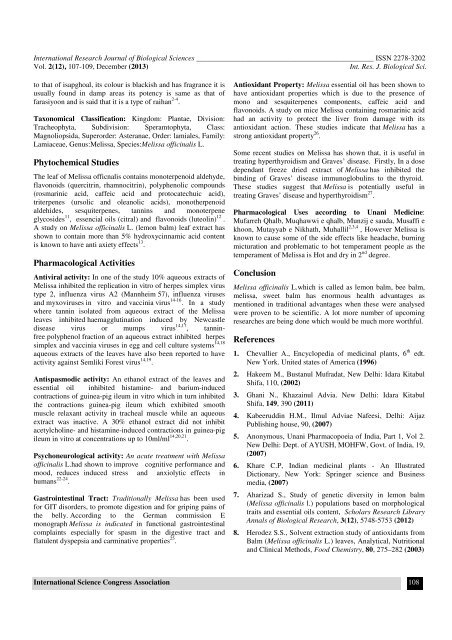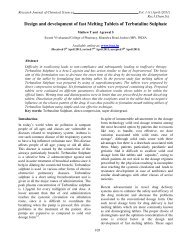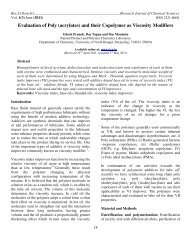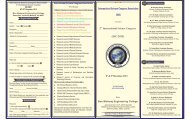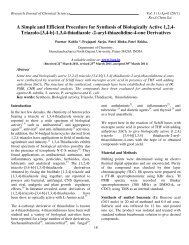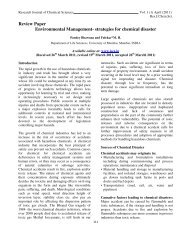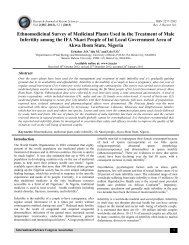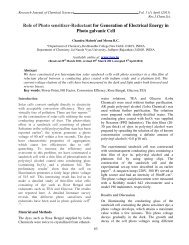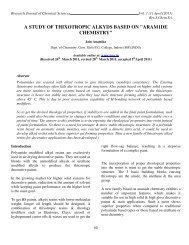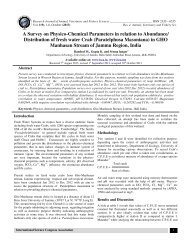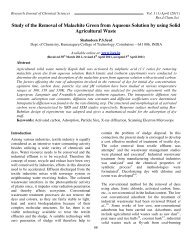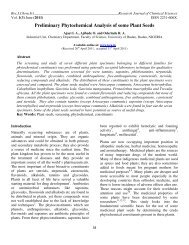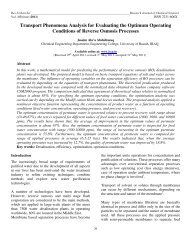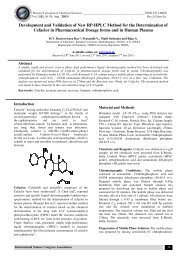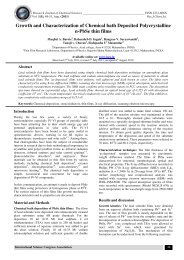An Overview of Badranjboya (Melissa officinalis) - ISCA
An Overview of Badranjboya (Melissa officinalis) - ISCA
An Overview of Badranjboya (Melissa officinalis) - ISCA
Create successful ePaper yourself
Turn your PDF publications into a flip-book with our unique Google optimized e-Paper software.
International Research Journal <strong>of</strong> Biological Sciences ________________________________________________ ISSN 2278-3202<br />
Vol. 2(12), 107-109, December (2013)<br />
Int. Res. J. Biological Sci.<br />
to that <strong>of</strong> isapghoal, its colour is blackish and has fragrance it is<br />
usually found in damp areas its potency is same as that <strong>of</strong><br />
farasiyoon and is said that it is a type <strong>of</strong> raihan 2-4 .<br />
Taxonomical Classification: Kingdom: Plantae, Division:<br />
Tracheophyta, Subdivision: Speramtophyta, Class:<br />
Magnoliopsida, Superorder: Asteranae, Order: lamiales, Family:<br />
Lamiaceae, Genus:<strong>Melissa</strong>, Species:<strong>Melissa</strong> <strong>of</strong>ficinalis L.<br />
Phytochemical Studies<br />
The leaf <strong>of</strong> <strong>Melissa</strong> <strong>of</strong>ficnalis contains monoterpenoid aldehyde,<br />
flavonoids (quercitrin, rhamnocitrin), polyphenolic compounds<br />
(rosmarinic acid, caffeic acid and protocatechuic acid),<br />
triterpenes (ursolic and oleanolic acids), monotherpenoid<br />
aldehides, sesquiterpenes, tannins and monoterpene<br />
glycosides 11 , essencial oils (citral) and flavonoids (luteolin) 12 .<br />
A study on <strong>Melissa</strong> <strong>of</strong>ficinalis L. (lemon balm) leaf extract has<br />
shown to contain more than 5% hydroxycinnamic acid content<br />
is known to have anti axiety effects 13 .<br />
Pharmacological Activities<br />
<strong>An</strong>tiviral activity: In one <strong>of</strong> the study 10% aqueous extracts <strong>of</strong><br />
<strong>Melissa</strong> inhibited the replication in vitro <strong>of</strong> herpes simplex virus<br />
type 2, influenza virus A2 (Mannheim 57), influenza viruses<br />
and myxoviruses in vitro and vaccinia virus 14-16 . In a study<br />
where tannin isolated from aqueous extract <strong>of</strong> the <strong>Melissa</strong><br />
leaves inhibited haemagglutination induced by Newcastle<br />
disease virus or mumps virus 14,17 , tanninfree<br />
polyphenol fraction <strong>of</strong> an aqueous extract inhibited herpes<br />
simplex and vaccinia viruses in egg and cell culture systems 14,18<br />
aqueous extracts <strong>of</strong> the leaves have also been reported to have<br />
activity against Semliki Forest virus 14,19 .<br />
<strong>An</strong>tispasmodic activity: <strong>An</strong> ethanol extract <strong>of</strong> the leaves and<br />
essential oil inhibited histamine- and barium-induced<br />
contractions <strong>of</strong> guinea-pig ileum in vitro which in turn inhibited<br />
the contractions guinea-pig ileum which exhibited smooth<br />
muscle relaxant activity in tracheal muscle while an aqueous<br />
extract was inactive. A 30% ethanol extract did not inhibit<br />
acetylcholine- and histamine-induced contractions in guinea-pig<br />
ileum in vitro at concentrations up to 10ml/ml 14,20,21 .<br />
Psychoneurological activity: <strong>An</strong> acute treatment with <strong>Melissa</strong><br />
<strong>of</strong>ficinalis L.had shown to improve cognitive performance and<br />
mood, reduces induced stress and anxiolytic effects in<br />
humans 22-24 .<br />
Gastrointestinal Tract: Traditionally <strong>Melissa</strong> has been used<br />
for GIT disorders, to promote digestion and for griping pains <strong>of</strong><br />
the belly. According to the German commission E<br />
monograph <strong>Melissa</strong> is indicated in functional gastrointestinal<br />
complaints especially for spasm in the digestive tract and<br />
flatulent dyspepsia and carminative properties 25 .<br />
<strong>An</strong>tioxidant Property: <strong>Melissa</strong> essential oil has been shown to<br />
have antioxidant properties which is due to the presence <strong>of</strong><br />
mono and sesquiterpenes components, caffeic acid and<br />
flavonoids. A study on mice <strong>Melissa</strong> containing rosmarinic acid<br />
had an activity to protect the liver from damage with its<br />
antioxidant action. These studies indicate that <strong>Melissa</strong> has a<br />
strong antioxidant property 26 .<br />
Some recent studies on <strong>Melissa</strong> has shown that, it is useful in<br />
treating hyperthyroidism and Graves’ disease. Firstly, In a dose<br />
dependant freeze dried extract <strong>of</strong> <strong>Melissa</strong> has inhibited the<br />
binding <strong>of</strong> Graves’ disease immunoglobulins to the thyroid.<br />
These studies suggest that <strong>Melissa</strong> is potentially useful in<br />
treating Graves’ disease and hyperthyroidism 27 .<br />
Pharmacological Uses according to Unani Medicine:<br />
Mufarreh Qhalb, Muqhawwi e qhalb, Munzij e sauda, Musaffi e<br />
khoon, Mutayyab e Nikhath, Muhallil 2,3,4 , However <strong>Melissa</strong> is<br />
known to cause some <strong>of</strong> the side effects like headache, burning<br />
micturation and problematic to hot temperament people as the<br />
temperament <strong>of</strong> <strong>Melissa</strong> is Hot and dry in 2 nd degree.<br />
Conclusion<br />
<strong>Melissa</strong> <strong>of</strong>ficinalis L.which is called as lemon balm, bee balm,<br />
melissa, sweet balm has enormous health advantages as<br />
mentioned in traditional advantages when these were analysed<br />
were proven to be scientific. A lot more number <strong>of</strong> upcoming<br />
researches are being done which would be much more worthful.<br />
References<br />
1. Chevallier A., Encyclopedia <strong>of</strong> medicinal plants, 6 th edt.<br />
New York. United states <strong>of</strong> America (1996)<br />
2. Hakeem M., Bustanul Mufradat, New Delhi: Idara Kitabul<br />
Shifa, 110, (2002)<br />
3. Ghani N., Khazainul Advia. New Delhi: Idara Kitabul<br />
Shifa, 149, 390 (2011)<br />
4. Kabeeruddin H.M., Ilmul Adviae Nafeesi, Delhi: Aijaz<br />
Publishing house, 90, (2007)<br />
5. <strong>An</strong>onymous, Unani Pharmacopoeia <strong>of</strong> India, Part 1, Vol 2.<br />
New Delhi: Dept. <strong>of</strong> AYUSH, MOHFW, Govt. <strong>of</strong> India, 19,<br />
(2007)<br />
6. Khare C.P, Indian medicinal plants - <strong>An</strong> Illustrated<br />
Dictionary, New York: Springer science and Business<br />
media, (2007)<br />
7. Aharizad S., Study <strong>of</strong> genetic diversity in lemon balm<br />
(<strong>Melissa</strong> <strong>of</strong>ficinalis l.) populations based on morphological<br />
traits and essential oils content, Scholars Research Library<br />
<strong>An</strong>nals <strong>of</strong> Biological Research, 3(12), 5748-5753 (2012)<br />
8. Herodez S.S., Solvent extraction study <strong>of</strong> antioxidants from<br />
Balm (<strong>Melissa</strong> <strong>of</strong>ficinalis L.) leaves, <strong>An</strong>alytical, Nutritional<br />
and Clinical Methods, Food Chemistry, 80, 275–282 (2003)<br />
International Science Congress Association 108


